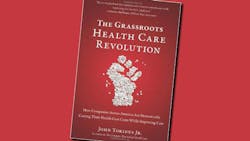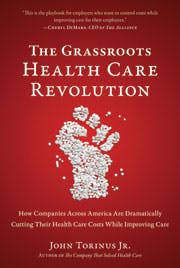Note to Manufacturers: Take Back Your Health Care Supply Chain
It can be done. “Manufacturers, by nature, are good managers,” explains John Torinus Jr., CEO of Serigraph. “If you apply lean and Six Sigma thinking to get your health care costs under control, it is possible to show the same favorable results in this arena that we see on the factory floor.”
Torinus says the overall goal is for companies to take back the health care supply chain. His company, which provides screen, digital and offset printed and molded products, was facing a 15% cost increase for health care in 2004. Using the methods he describes in his new book, The Grassroots Health Care Revolution, he has kept the total costs to an average of less than 3% per year.
“One of the things I like about this opportunity is that the savings are so big and rewards so huge,” said Torinus.“ And if you don’t do it the pain so high.”
The savings came not through drastic cuts, but instead a well-managed process. The self-insured company uses consumer-driven plans, provides free generic drugs and full transparency into drug prices. There is an on-site clinic (unusual for an employee base of 500), with concierge doctor, dietician and chiropractor.
The secret to his success comes straight from the manufacturing handbook. He makes sure all of his platforms work together and has a clear roadmap. In the book he shares a practical, yet comprehensive plan.
Three Year Road Map to Best Practices in Delivery of Health Care
Year One – Get Started
- Go self-insured
- Introduce consumer-driven health plan
- Set up tiered drug management to promote generics
- Change culture to health care vs. sick care
Year Two – Buying Smart
- Make price, quality transparent
- Seek out Centers of Value
- Demand bundled bills
Year Three- Proactive Care
- Install on-site primary care
- Create medical home
- Tackle chronic diseases with Six Sigma discipline
- Treat health as financial asset
Disruptive Business Model
The key to deploying the plan above, explains Torinus, is to employ a disruptive business model relative to health care. “We know how to eliminate waste and remove defects, now we need to apply this to health care.”
But first he says companies need to take back control of the supply chain.
“Chief executive officers across America, with a few exceptions, should offer a class-action apology for allowing the economics of health care to get totally out of control,“ Torinus states in the book. He explains that while companies paid a lot of money to fix major problems very few have raised health care to the level of a strategic priority. The biggest problem is that the CEOs didn’t create a marketplace to bring supply and demand discipline to the delivery of health care. They allowed providers to vertically integrate the health care supply chain, “to the great disadvantage of employers and their employees. “
The best way to change this current state is to provide transparency into both the costs and quality of services. “Employers are shocked to learn, through transparency websites, that prices can vary as much as 300%, says Torinus. An MRI, for example, can cost less than $300 and up to $2000.
Another tactic (under Year 2) is what Torinus calls “centers of value.” The concept is value-based pricing. For example when Lowe’s cut a deal with the Cleveland Clinic for cost-effective heart surgeries, it was based on this concept. “At a Center of Value, employers and their employees can buy world-class quality at attractive, all-inclusive, bundled prices,” says Torinus. Companies are quickly catching on. Boeing, Alliance Oil, Walmart and many others use this system.
Other companies, such as Briggs & Stratton, set up on-site clinics to take control of their supply chain. This method has a high ROI. According to Walgreens, which through its affiliate Take Care Health Systems is one of the largest providers of worksite health care, for every $1 invested the return is $5.82.
But you don’t have to be as large as BMW, which uses Walgreen’s clinics, to have the benefits of an on-site clinic. “Mid-sized companies are also jumping to the on-site business model,” says Torinus. “If they are short the 800-1000 employee level, they use part-time nurses, nurse auctioneers and concierge doctors on site. “
Bringing in experts to help manage these issues is viable for any size company explains Torinus. His company uses a variety of providers including new entrepreneurial firms who can provide the data-gathering and analysis that is necessary.
"Companies have learned that health care costs can be managed, and they have discovered they are in the business of behavior change," says Torinus. “They have calculated that a well-managed health plan can be a competitive advantage.”


